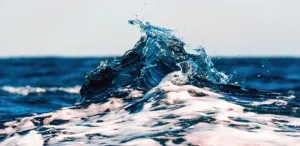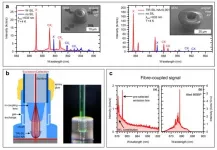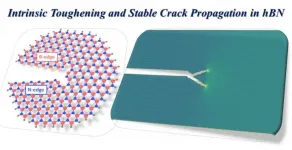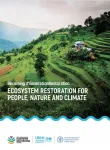Electrochemical cell harvests lithium from seawater
2021-06-03
(Press-News.org) Lithium is a vital element in the batteries that power electric vehicles, but soaring lithium demand is expected to exhaust land-based reserves by 2080. KAUST researchers have now developed an economically viable system that can extract high-purity lithium from seawater.
The oceans contain about 5,000 times more lithium than the land but at extremely low concentrations of about 0.2 parts per million (ppm). Larger ions, including sodium, magnesium and potassium, are all present in seawater at much higher concentrations; however, previous research efforts to tease lithium from this mixture have yielded little.
The KAUST team solved this problem with an electrochemical cell containing a ceramic membrane made from lithium lanthanum titanium oxide (LLTO). Its crystal structure contains holes just wide enough to let lithium ions pass through while blocking larger metal ions. "LLTO membranes have never been used to extract and concentrate lithium ions before," says postdoc Zhen Li, who developed the cell.
The cell contains three compartments. Seawater flows into a central feed chamber, where positive lithium ions pass through the LLTO membrane into a side compartment that contains a buffer solution and a copper cathode coated with platinum and ruthenium. Meanwhile, negative ions exit the feed chamber through a standard anion exchange membrane, passing into a third compartment containing a sodium chloride solution and a platinum-ruthenium anode.
The researchers tested the system using seawater from the Red Sea. At a voltage of 3.25V, the cell generates hydrogen gas at the cathode and chlorine gas at the anode. This drives the transport of lithium through the LLTO membrane, where it accumulates in the side-chamber. This lithium-enriched water then becomes the feedstock for four more cycles of processing, eventually reaching a concentration of more than 9,000 ppm. Adjusting the pH of this solution delivers solid lithium phosphate that contains mere traces of other metal ions -- pure enough to meet battery manufacturers' requirements.
The researchers estimate that the cell would need only US$5 of electricity to extract 1 kilogram of lithium from seawater. The value of hydrogen and chlorine produced by the cell would more than offset this cost, and residual seawater could also be used in desalination plants to provide freshwater.
"We will continue optimizing the membrane structure and cell design to improve the process efficiency," says group leader Zhiping Lai. His team also hopes to collaborate with the glass industry to produce the LLTO membrane at large scale and affordable cost.
INFORMATION:
[Attachments] See images for this press release:

ELSE PRESS RELEASES FROM THIS DATE:
2021-06-03
Quantum computing and quantum communication are believed to be the future of information technology. In order to achieve the challenging and long-standing goal to make secure, wide-spread quantum communication networks a reality, high-brightness single-photon sources are indispensable. Single-photon emission from semiconductor quantum dots (QDs) has been shown to be a pure and efficient non-classical light source with a high degree of indistinguishability. However, the total internal reflection (TIR) as a result of the high semiconductor-to-air refractive index contrast severely limits the single-photon extraction efficiency. Another crucial step in the development ...
2021-06-03
For decades, researchers have debated whether the buildup of certain electrical activities in the brain indicates that human beings are unable to act out of free will.
Experiments spanning the 1960s and 1980s measured brain signals noninvasively and led many neuroscientists to believe that our brains make decisions before we do--that human actions were initiated by electrical waves that did not reflect free, conscious thought.
However, a new article in Trends in Cognitive Science argues that recent research undermines this case against free will.
"This new perspective on the data turns on its head the way well-known findings have been interpreted," said Adina Roskies, the Helman Family Distinguished Professor and professor of philosophy at ...
2021-06-03
Durham, NC -- Type 2 diabetes patients who are not overweight and who have had the disorder for less than a decade can benefit from stromal stem cells transplanted from their own bone marrow, according to a study published today in STEM CELLS Translational Medicine.
In a randomized clinical trial at Vinmec Research Institute of Stem Cell and Gene Technology in Hanoi, Vietnam, researchers investigated the safety and potential therapeutic value of administering bone marrow stromal stem cells to patients with Type 2 diabetes. In each case, the cells were autologous, ...
2021-06-03
SAN FRANCISCO, CA (June 3, 2021) -- Since arriving to the northern Atlantic Ocean less than 30 years ago, lionfish have quickly become one of the most widespread and voracious invasive species, negatively impacting marine ecosystems--particularly coral reefs--from the northeast coast of the United States to the Caribbean Islands. In a new study, an international research team including the California Academy of Sciences presents four new records of lionfish off the coast of Brazil, confirming the invasion of the predatory fish into the South Atlantic for the first time. Their findings, published today in Biological Invasions, discuss how the lionfish may have arrived in the ...
2021-06-03
A team of scientists led by Nanyang Technological University (NTU Singapore) and Rice University in the US, has uncovered the key to the outstanding toughness of hexagonal boron nitride (h-BN). h-BN can withstand ten times the amount of force that graphene can, which is known as one of the toughest materials on Earth.
A two-dimensional (2D) material, h-BN has a thickness of just one atom. First used in cosmetics in the 1940s, it was soon abandoned due to its high price, making a resurgence in the late 1990s after technology made its production cheaper.
Today, it is used by nearly all leading producers of cosmetic products because of its ability to absorb excess facial sebum and disperse pigment evenly, ...
2021-06-03
Mangrove vegetation, which grows naturally in subtropical shorelines, provides a wide range of ecosystem functions such as reducing coastal erosion, promoting biodiversity, and removing nitrogen, phosphorus and carbon dioxide. These vital ecological functions are influenced by the water flow around the intricate mangrove roots, which create a complex energetic process that mixes up sediments and generates a depositional region behind the roots. How these mangrove roots interact with water flow is believed to be a key element in mitigating coastal erosion.
Accurately projecting hydrodynamic erosion and the essential amount of mangrove species has been a challenge for managers and restoration experts to forecast a successful component of project designs. That is because ...
2021-06-03
WASHINGTON (June 3, 2021) - Nearly three-quarters of breast cancer patients (73%) report using at least one type of complementary medicine after cancer diagnosis, while oncologists believe that less than half (43%) of patients are using these approaches during cancer care. These and other findings from a national survey of oncologists and breast cancer patients were released in conjunction with the 2021 ASCO Annual Meeting. The study found that doctors report discussing integrative health with only about half of patients, leading patients to seek information outside the clinic.
"Cancer is a complex ...
2021-06-03
Astronomers studying the fast-moving jet of material ejected by a still-forming, massive young star found a major difference between that jet and those ejected by less-massive young stars. The scientists made the discovery by using the U.S. National Science Foundation's Karl G. Jansky Very Large Array (VLA) to make the most detailed image yet of the inner region of such a jet coming from a massive young star.
Both low- and high-mass young stars, or protostars, propel jets outward perpendicular to a disk of material closely orbiting the star. In stars with masses similar to the Sun, these jets are narrowed, or focused, relatively tightly near to the star in a process called collimation. Because most high-mass protostars are more distant, studying ...
2021-06-03
New research into Alzheimer's disease (AD) suggests that secondary infections and new inflammatory events amplify the brain's immune response and affect memory in mice and in humans - even when these secondary events occur outside the brain.
Scientists believe that key brain cells (astrocytes and microglia) are already in an active state due to inflammation caused by AD and this new research shows that secondary infections can then trigger an over-the-top response in those cells, which has knock-on effects on brain rhythms and on cognition.
In the study, just published in Alzheimer's & Dementia, the journal ...
2021-06-03
Facing the triple threat of climate change, loss of nature and pollution, the world must deliver on its commitment to restore at least one billion degraded hectares of land in the next decade - an area about the size of China. Countries also need to add similar commitments for oceans, according to a new report by the UN Environment Programme (UNEP) and the Food and Agriculture Organization of the UN (FAO), launched as the UN Decade on Ecosystem Restoration 2021-2030 gets underway.
The report, #GenerationRestoration: Ecosystem restoration for People, Nature and Climate, highlights that humanity is using about 1.6 times the amount of services that nature can provide sustainably.
That ...
LAST 30 PRESS RELEASES:
[Press-News.org] Electrochemical cell harvests lithium from seawater




